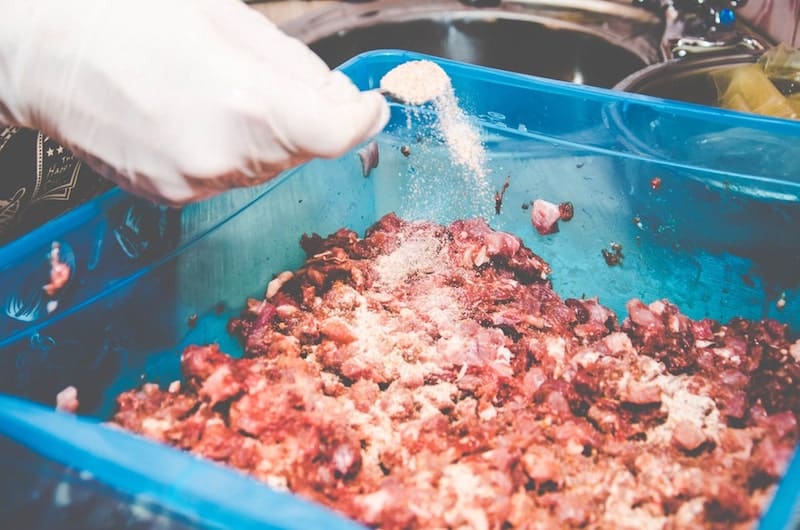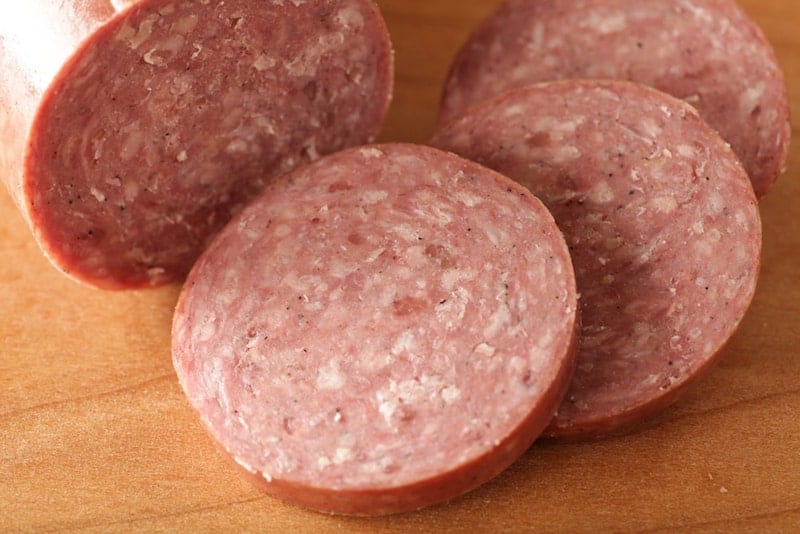Curing Summer Sausage: Everything You Need to Know
A charcuterie board is a fantastic way to impress your guests, especially if you serve homemade summer sausage. But to be a big hit, your summer sausage needs to be adequately cured.
Curing summer sausage is a time-consuming but gratifying hobby, as long as you know what you’re doing. The goal of curing any meat is to remove the moisture and give it new textural properties unsuitable for bacterial growth.
In this article, I’ll tell you everything you need to know about how to safely make summer sausage and elaborate on the proper curing process.

Does Summer Sausage Need to Cure?
Making homemade summer sausage can be a lengthy process. Even with a smoker, it can take anywhere from half a day to three days to smoke the summer sausage (and this is only the final step).
You might be tempted to shorten the process by skipping the curing part, especially if you’re planning to eat the summer sausage straight away. This would be a big mistake.
Curing your summer sausage is essential. It will prevent botulism, which has a high risk of occurrence, given the fact that you’ll cook the sausage at a very low temperature. This is a potentially deadly disease caused by toxins from Clostridium botulinum bacteria.
If you’re making fresh sausage, such as breakfast sausage, which will be cooked straight away at high temperatures, you don’t need to add cure.
To reiterate, making homemade summer sausage means you must use a curing salt to prevent the growth of harmful bacteria that could harm your health.
How Do You Cure Summer Sausage?
Curing summer sausage requires the use of curing salt. It’s not enough to simply mix the salt into the meat, along with seasonings; you also have to let it “cure” for a while.
Let’s review the entire process. First, you need to choose the meat you’ll use in your summer sausage. You need around 30% of fat to get the best results, so it’s better to choose fattier meats.
If you use leaner meat, add some pork or beef fat. Also, some non-fat dry milk will bind the sausages well and prevent clumping of the fat. Add the seasonings you need for your summer sausage. Mustard seed, ground pepper, cayenne, chili, garlic, thyme, and cloves are the usual choices, but you can season it to your taste. You can also add cheese, if you’d like.
Then, add the curing salt (see below for exactly how much to use), and mix everything together. Mixing should be thorough, and you should get the sticky feeling of the meat. While it might not be the most pleasant option, using your hands for mixing is optimal.
When everything is blended well, place the sausage mix in a bowl or a freezer bag and refrigerate to start the curing process (see below for exactly how long this should take).
Once the meat is cured and has been stuffed into sausage casings, you can cook your summer sausage in a smoker or a grill.
You should set up the temperature between 110°F and 130°F until you get the desired color. Then, gradually increase the temperature to 150-170°F. After a while, go up to 190°F, but never higher than that.
You can also make summer sausages in the oven if you don’t have a smoker or a grill. First, stick to the lowest temperature setting, usually 170°F, and then slowly increase to 190°F.
You’re likely looking at a process that will take anywhere from six hours to three days.
Also, once you’ve smoked the sausage, you’ll need to let it sit for a while and dry slightly. That can take from several days to a week. Only then should you slice and taste it.

How Much Cure to Use for Summer Sausage
Making homemade summer sausage allows for experimenting when it comes to seasonings and what types of meat you’ll use. But when it comes to curing, this is one area where following the rules are vital.
Experienced sausage makers might not need to measure every ounce of meat and curing salt to ensure the meat is cured correctly, but if you’re a novice, this is advised.
As a rule for measuring the amount of cure you’ll need for summer sausage, one pound of meat will require one tablespoon of curing salt.
For some, this might seem like it’s too much, and for others, it’s not enough, but this is the correct ratio – make sure to stick to it for best results.
With cured meat, anything that tastes odd is better to dismiss immediately. If your summer sausage doesn’t taste as it should after it was cured, it’s best not to consume it.
How Long to Cure Summer Sausage
Once curing salt has been added to the meat, the mixture needs to sit in the refrigerator for at least 24h. That’s when the curing salts will work their magic. Make sure to knead the meat at least once during the curing time.
Your summer sausage should lose around 35% of its original weight when it’s fully cured. The amount of time it will require depends on how big the sausage links are and the cooking temperature.
Best Curing Salt for Summer Sausage
Curing salts for meats and sausages are a mix of table salt, sodium nitrite (NaNO2), and sodium nitrate (NaNO3.) You don’t have to mix these ingredients yourself. You can buy them already mixed, in correct proportions, which is crucial.
Curing salts come in two categories, Curing Salt #1 and Curing Salt #2. For making summer sausage, you’ll need Curing Salt #1.
Other names for Curing Salt #1 include Prague Powder #1, Insta Cure #1, and pink curing salt. It’s for short-term cures and is often used for semi-dry meats and sausages (like summer sausage).
Curing Salt #2 is also known as Prague Powder #2, Insta Cure #2, and slow cure. It’s used for cures that take weeks and even months; therefore, they are not suitable for sausages.
It’s important to note that curing salt for sausages shouldn’t be confused with pink Himalayan salt, which also has a pink hue.
In Summary
The good news about making homemade summer sausage is that it takes less time than other cured meats. You can have your sausage ready in a matter of days. However, curing summer sausage should in no way be a rushed process.
Make sure you stick to the recommended amounts of curing salts and allow the meat to cure for the appropriate amount of time. The commercial blends usually have instructions on how to use them accurately.
As with all meat, tread cautiously and discard anything that tastes funny in any way. The curing process is crucial not only for the taste but also for your health.






